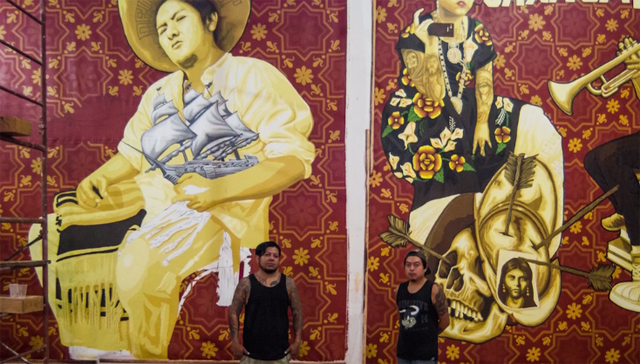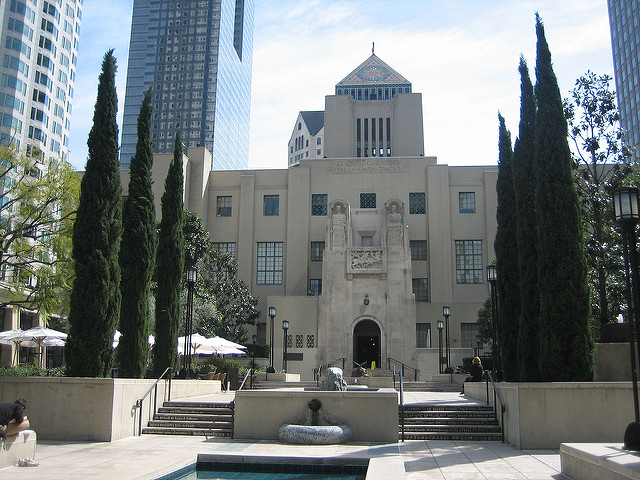The U.S. government prevented two celebrated Zapotec artists from attending the closing reception last week for their murals, displayed for a year in the central rotunda of the Los Angeles Public Library. The Los Angeles Times reported last Wednesday that artists Dario Canul and Cosijoesa Cernas, from the Zapotec street art collective Tlacolulokos, were not allowed to return to the U.S., despite the fact (or perhaps because of the fact) that their murals had been quite popular, attracting almost 100,000 visitors over the course of the year that they were on display.

The eight murals by the two artists, in a show entitled “Visualizing Language,” represented the large Zapotec community in Los Angeles and the intersections of cultures between the U.S. metropolis and the smaller communities where they live in southern Mexico. The works of art were installed in the central library’s rotunda directly beneath a 1933 mural by artist Dean Cornwell, which depicts the early history of California in terms of Native Americans bowing to colonialists from Europe. The Tlacolulokos works carry a contradictory message of vibrant pride, yet a sense of change and variety. An article about the exhibit published in January 2018 erroneously stated that it would close at the end of that month.
The thrust of the newspaper report last week was an attempt to make sense about the denials of visas for the two artists. Apparently Canul and Cernas had flown into the San Francisco International Airport on January 8 to investigate the possibility of a creative project there but, on arrival, immigration officials confiscated their tourist visas, held them in detention overnight, and put them on a plane back to Mexico in the morning. They were banned from returning to the U.S. for five more years. “La banda estaba sacada de onda [We were freaked out],” Canul told L.A. Taco, a website reporting on the incident.

Despite the efforts of the LA Times reporter to get out the facts in the case, a lot remains murky. The reporter went to the Los Angeles Public Library for comment and received only silence. Oddly, the two officials at the library responsible for putting on the exhibit had both left their positions on Wednesday the 29th, the day the newspaper was investigating the story. Louise Steinman, the director of the library’s ALOUD series of cultural events and Maureen Moore, her associate director, had both left that day. Steinman was a key person in promoting the “Visualizing Language” exhibit and Moore was its producer.
The newspaper spoke with Carlos Rogel, the interim executive director of the Social and Public Art Resource Center (SPARC), a Los Angles arts nonprofit organization. He said that artistic exchanges have been very important in LA, especially to the arts institutions, but this sort of thing, with international artists being denied their visas, has happened before. It’s “a way of censoring their work here,” he said.
According to the L.A. Taco website, Xochitl Flores-Marcial, who is a professor at Cal State Northridge, had indicated that the library had contacted immigration attorneys earlier this year about Canul and Cernas but it was already too late by the time they inquired.
The newspaper spoke with Jesse Lerner, a curator who has organized numerous arts projects between Los Angles and Latin America, about the denial of the visas for the two Zapotec artists. He said that their rights to free speech, such as having conversations with art galleries, even discussing commissions, would not have violated their tourist visas. He added, “everything’s gotten harder for artists because of a racist, xenophobic administration in Washington.”
The murals are headed for Lille, France, where they will be part of a celebration of Mexican culture in that city. Then they will come back to California where they will be part of the permanent collection at the Museum of Latin American Art in Long Beach. Through a spokesperson, the president of that museum, Lourdes Ramos, expressed her regrets that the two artists were prevented from coming to the closing event on the 26th. She said she was confident that the visa issue could be resolved so they could continue to serve “as cultural ambassadors of the Mexican artistic tradition.”